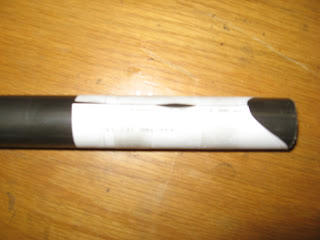

CASCADIA to HIMALAYA

 I tapered the seat tubes by cutting them at arbitrary angle and then placing a small piece of metal on top and then welding and grinding. The seat tube to seat stay weld was by far the most difficult on the bike.
I tapered the seat tubes by cutting them at arbitrary angle and then placing a small piece of metal on top and then welding and grinding. The seat tube to seat stay weld was by far the most difficult on the bike.
 Is the inspiration for:
Is the inspiration for:| Seat Tube Length (Center-Top) | 630mm | |||||||||
|---|---|---|---|---|---|---|---|---|---|---|
| Top Tube Length (Center-Center) | 625.0mm | |||||||||
| Head Tube Angle | 72.0° | |||||||||
| Seat Tube Angle | 73.0° | |||||||||
| BB Drop | 50.0mm | |||||||||
| Chainstay Length | 460.0mm | |||||||||
| Wheelbase | 1085.3 | |||||||||
| Head Tube Length | 210.0mm | |||||||||
| Fork Length | 390.0mm | |||||||||
| Fork Rake | 45.0mm |










 Figure 1: Miter Program
Figure 1: Miter Program Figure 2: Wrap before you... miter!
Figure 2: Wrap before you... miter! Figure 3: Checking it twice.
Figure 3: Checking it twice.

Lugs used to be the preferred way to build fine bicycle frames. Then makers discovered tig-welds, and almost overnight (considering the long, 90-year reign of lugs, the 6-year period between about 1981 and 1987 constitutes overnight), tig-welding took over. It is a strong way to join tubes. It is efficient. It has proven its merit thousands of times over. A body can appreciate a good tig-weld, and should appreciate the skills that go into it. But a lug is a lug, and a tig-weld ain't.
They are beautiful, no doubt it - but I don't know - if I did choose to Lug design, I feel like some naked minimalist would be pacing behind me furrowing his brow (looking real concerned). Here is another article which supports lug soldering rather than welding:
On Strength
In the late '80s, a team of scientists in the UC Davis engineering department undertook an in-depth look at the relative strengths of various steel joining techniques at the request of "Bicycle Guide" magazine. The three top frame builders associated with the three primary joining techniques were asked to supply joining samples using tubing supplied to the builders from the same mill run. Tom Ritchie provided the fillet-brazed samples, tig-welding was done by Gary Helfrich, and the silver soldered lugged samples were done by Spectrum's Jeff Duser. The samples were fatigue tested, in some cases to failure. In most cases, the joints did not fail. More often, the tubes failed at or near the joint. The team's study involved microscopic analysis of the crystal structure of joining zones, heat effected zones and failure sites. They concluded that all three joining techniques, done properly, are clearly of sufficient strength for the purpose of bicycle frame construction. The different results obtained from the samples resulted primarily in the heat-affected areas of the tubes themselves. Not surprisingly, the tubes that were soldered turned out to be stronger than the tubes that were welded or brazed. So, what does this mean in the real world? Frames built with silver soldered lugs will last longer than those that are fillet brazed and considerably longer than those that are welded. However, for most of our customers, the real practical difference is that lugged frames hold up in crashes better, and when it becomes necessary, they are much easier to repair.
So there is a lot of merit to Lug design - ease in tube repair, stronger, and arguably more beautiful (maybe easier to put together as well? - I'm not experienced so I don't know). I hope some boot strapped practical vintage-head (conundrum?) won't be strolling along behind me when I decide to choose TIG over LUG (both three letter words that end in G, by the way). The only reason I'm choosing TIG, I would tell him, is because I've gotten advice from other experienced people, because I myself, don't really know all that I'm getting into. "This is my first bike!" I would beg as he took out his 1940's era buck knife and tried to finagle me into some kind of novel 1/2 nelson. I just hope the naked, and modern, minimalist would be there to fend off the incoming dude.
